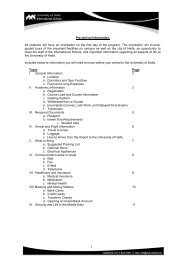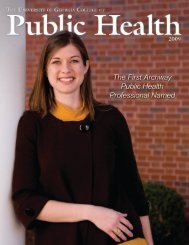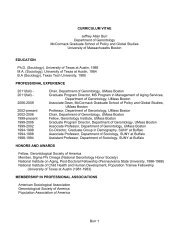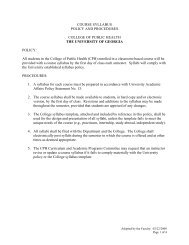Environmental <strong>Health</strong> ScienceBeyond AcademiaUptatum qui eu feummodignaacincil essectemincilit in ver illaore faciduitatin henibh eugait iuremagnit wisci tin etum ditIn Environmental <strong>Health</strong> Science, the pr<strong>of</strong>essors andtheir students are detectives, <strong>of</strong>ten examining the smallerdetails—whether it’s Prozac in frogs or Listeria in guineapigs—to get the big picture. The results have impact beyondthe academic community, perhaps best illustrated by NakanishiMotor Corporation’s recent decision to alter productionat their Athens’ plant, all prompted by a student study <strong>of</strong> airbornetoxins (see cover story).Air pollution is not the only environmental public healthconcern. Assistant pr<strong>of</strong>essor Erin Lipp is researching waterbornesalmonella in a toxic hotbed that sorely needs help.“We’ve consistently been the top for salmonella cases inthe country,” she says.Indeed, in 2002, the national average <strong>of</strong> salmonella caseswas 11.5 per 100,000 people. The Georgia average for thatyear was 23.5 per 100,000, and in the Valdosta area, it was80.5 per 100,000.As the salmonella strains in south Georgia aren’t commonlyassociated with food production, Lipp’s team is studyingthe Little River watershed in Turner and Tift counties.So far, they’ve found that salmonella cases rise with peakingsummer temperatures and increased rainfall, and their findingshave big potential for the residents <strong>of</strong> that area.Such work “is satisfyingbecause you know what you’redoing has an impact.”- Erin Lipp“The state is interested in putting together educationalinformation on this, because it’s such a burden to the area,”says Lipp. Her research will help educate residents abouthow to avoid contamination, and it may trigger more intenseinvestigation from the state to hone in on actual sources <strong>of</strong>salmonella.Such work “is satisfying because you know what you’redoing has an impact,” she says.Marsha Black, Associate pr<strong>of</strong>essor and EHS interim departmenthead, also works with water. Her recent researchhas found that Prozac in the water supply has significant impacton aquatic animals. Gambusia affinis (or mosquito fish)exposed to Prozac take a significantly longer time to reachreproductive maturity; Xenopus laevis (African clawed frogs)exposed to Prozac experience delays in undergoing metaphorphosis,and are smaller once they do reach metamorphosis,which increases their risk for predation—as smallerfrogs, they can be eaten by smaller animals, increasing thepool <strong>of</strong> predators.There are several human implications beyond just theinterest Black’s research holds for aquatic health.The aquatic animals “are early warning signals for chemicalsthat might ultimately harm humans,” she says. Knowingthat the chemicals are in the water in the first place can leadto improved water treatment processes. Also, as frog metamorphosisis cued by the thyroid, Black can study relationshipsbetween Prozac and human thyroid production.Associate pr<strong>of</strong>essor Mary Alice Smith’s research <strong>of</strong> Listeriacontamination in monkeys and guinea pigs may one daylead to vaccines or new treatment therapies for the toxin’s8 <strong>College</strong> <strong>of</strong> <strong>Public</strong> <strong>Health</strong>
susceptible targets: pregnant women,older adults and people with compromisedimmune systems.Pregnant women infected withListeria can have stillbirths. “Fortunately,it doesn’t happen a lot, butwhen it does, it’s a devastating thing,”says Smith. Older people or thosewith compromised immune systemsare also susceptible to the toxin.Smith’s research may reveal if there isany amount <strong>of</strong> Listeria exposure thatis safe.Like all <strong>of</strong> her colleagues, Smith<strong>of</strong>ten works with other researchesacross campus. The <strong>College</strong> <strong>of</strong> <strong>Public</strong><strong>Health</strong>’s interdisciplinary nature iscrucial, Smith says.“To really tackle the big problemsin terms <strong>of</strong> a disease, you have to collaborate,”she says. “No one personhas all the expertise to do all that has tobe done. My success with the Listeriawork has been because I’ve collaboratedwith microbiologists, pathologists,primatologists, immunologists…It reallytakes a whole team <strong>of</strong> people tounderstand that disease process.”And in the end, Smith, like hercolleagues, takes satisfaction knowingthat her work serves the interests <strong>of</strong>public health.“I really enjoy doing researchthat has potential for outside <strong>of</strong> academics,”she says.—Mary Jessica HammesFrom left to right: John Pearce, Megan Williams, Gordon Martin, and David BrownOh, the Places You’ll GoLooking back at his experience at the <strong>College</strong> <strong>of</strong> <strong>Public</strong> <strong>Health</strong>, JohnPearce remembers taking air samples in Peru, fine-tuning cutting-edge geospatialtechnology and winning first prize in a poster competition in Paris.“I can honestly say that the <strong>College</strong> took me places I never thought I wouldgo,” he says.Pearce graduated last spring with a master’s degree in environmental healthand certification in geographic information systems and plans to pursue a Ph.D.He found his taste for science as a boy in Clayton, Ga.“My mom was a science teacher,” he says. “When I was a kid, I was alwaysreading guide books and National Geographic. I was like, ‘This is so cool!’ Andthat’s when I first became interested in science.”While getting his bachelor’s degree in ecology at UGA, Pearce was introducedto a branch <strong>of</strong> geospatial technology called geographic information systems,or a computer-based system that handles spatial information and can createmaps. The technique is adaptable to many fields, including forestry, ecology,geography and urban planning. He found it “fascinating and revolutionary.”Between undergraduate and graduate studies, he familiarized himself evenmore with the technology while working for a local planning company.“I was impressed with what the technology could do, and wanted a challengingproblem to apply it to,” he says.He found that challenge in Cusco, Peru. In summer <strong>of</strong> 2005, Pearce waspart <strong>of</strong> a student team who traveled to Cusco with Luke Naeher, assistant pr<strong>of</strong>essorin Environmental <strong>Health</strong> Science, to research air pollution there. Naeher,who was recognized as the <strong>2007</strong> Outstanding Teacher for the <strong>College</strong> <strong>of</strong> <strong>Public</strong><strong>Health</strong> at last spring’s Honors Day, directed the project, along with ManuelAguilar Villalobos <strong>of</strong> Environmental Air Association, Lima–Peru, Cusco’s cityhall and Cusco’s department <strong>of</strong> health and transportation.The researchers found that air pollution levels were relatively high both onthe streets congested with traffic and in homes, where cooking is fueled by openfires—sometimes made from toxic plastics. Another concern is the combination<strong>of</strong> thin air and increased rates <strong>of</strong> respiratory illness, as 800,000 tourists visitCusco yearly to explore ancient Incan ruins in the mountains.In October 2006, Naeher and others traveled to Cusco to share the teams’findings with city <strong>of</strong>ficials, thus ensuring future collaboration between UGAand Peruvian universities with the hope <strong>of</strong> developing policies and regulationsto control the pollution.As for Pearce, his poster on the project went to the International Society <strong>of</strong>Exposure Analysis 2006 Conference in Paris. He won first place in the studentcompetition.“I was very surprised to win the award and was quite honored,” he recalls.—Mary Jessica HammesWinter <strong>2007</strong> 9
















